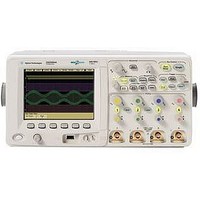DSO5012A AGILENT TECHNOLOGIES, DSO5012A Datasheet - Page 4

DSO5012A
Manufacturer Part Number
DSO5012A
Description
OSCILLOSCOPE, 100MHZ, 2 CHANNEL, 2GSPS
Manufacturer
AGILENT TECHNOLOGIES
Datasheet
1.DSO5012A.pdf
(23 pages)
Specifications of DSO5012A
Scope Type
Digital
Scope Channels
2 Analog
Bandwidth
100MHz
Meter Display Type
TFT-LCD Color
Sampling Rate
2GSPS
Input Impedance
1Mohm
Rise Time
3.5ns
Input Voltage
400V P-p
Lead Free Status / RoHS Status
na
Why does deep memory matter?
See more time
Seeing more time is the most easily
understood use of deep memory. The
more samples you acquire, the more
time you can see at a particular sample
rate.
Long capture times give you better
visibility into cause-effect relationships
in your design, which greatly simplifies
root-cause debugging. It also allows
you to capture start-up events (like
the start-up sequence in Figure 1) in a
single acquisition.
Figure 1.
Figure 2.
4
100 MSa/s
10 MSa/s
100 kSa/s
10 GSa/s
10 kSa/s
1 MSa/s
1 GSa/s
1 kSa/s
ns/div
1
ns/div
10
Inflection occurs at
200 ns/div
ns/div
100
5 GSa/s, 10k memory
µs/div
1
Time Base
µs/div
Inflection occurs at
10 µs/div (20 s with single-shot trigger)
10
You don’t have to stitch together
multiple acquisitions or set precise
triggering conditions. Spend less
time finding events, and more time
analyzing them.
See more details
The relationship between memory
depth and acquisition rate isn’t as
obvious. All scopes have a “banner”
maximum sample rate specification,
but many can only sustain these rates
at a few timebase settings.
µs/div
100
4 GSa/s, 1M memory
ms/div
1
ms/div
10
ms/div
100
s/div
1
In the case of an oscilloscope with a
5 GSa/s acquisition rate and 10-Kpts of
memory (Figure 2), those 10,000 points
can only fill 2 μs of time. Since scopes
have 10 time divisions, the sample rate
drops at any time/div setting below
200 ns/div.
As a result, if you look at “slow/fast”
events like a modulated signal, you
run the risk of aliasing your signal. Or
you may simply miss out on important
signal details when you zoom in on it.
Deep memory oscilloscopes let you
sustain a high sample rate over longer
periods of time.
Always fast, always on
MegaZoom III is the third generation of
the fast and deep memory architecture
that Agilent introduced in 1996. It’s
not a special mode, unlike other deep-
memory oscilloscopes. You have access
to your MegaZoom memory at all times.
And the display will respond instantly
to your commands as you scale the
+/div setting or pan and zoom in the
Delayed (or “zoom”) window.










